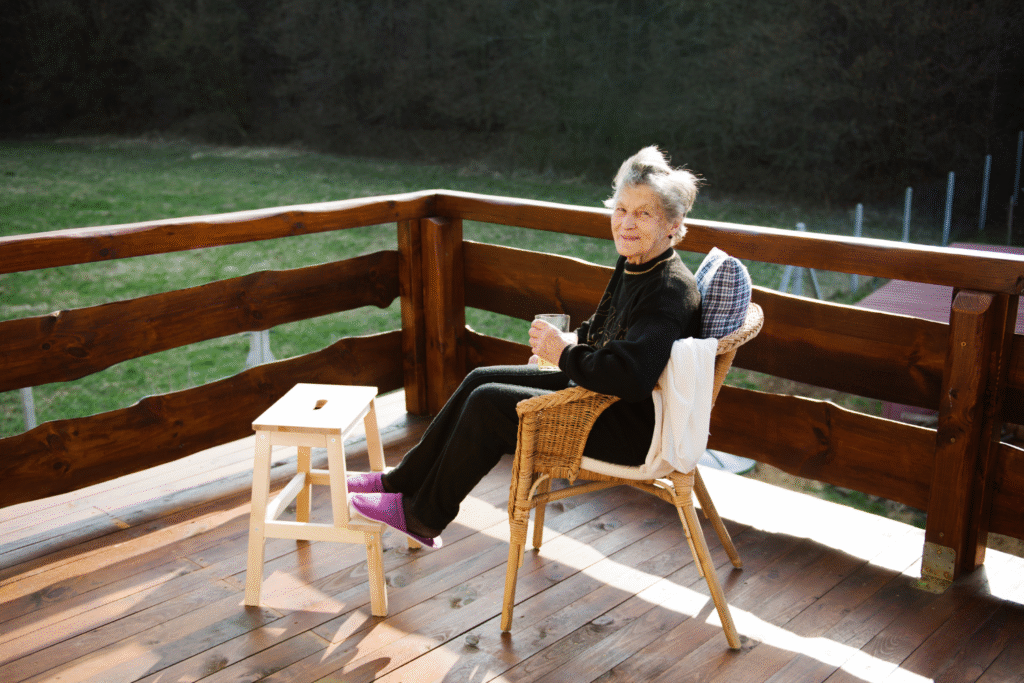Staying put is the new american dream for seniors.

The idea of downsizing or relocating might sound appealing in theory, but an overwhelming number of baby boomers are choosing to age in place instead. Their homes represent far more than just property values and square footage. These spaces hold decades of memories, established routines, and carefully cultivated communities that can’t be replicated elsewhere.
Financial considerations, emotional attachments, and practical concerns all play into this decision. Understanding why this generation is so committed to staying put reveals much about their priorities and the housing market’s future.
1. Mortgage rates locked in at historic lows make moving financially foolish.

Many baby boomers refinanced their homes during the unprecedented low-rate period between 2020 and 2021, securing mortgages around 3% or even lower. Giving up these rates to purchase another home in today’s market, where rates hover above 6%, would mean significantly higher monthly payments even on a less expensive property. The math simply doesn’t work in their favor.
Beyond the rate differential, selling means losing out on years of building equity in a favorable loan structure. Some boomers have already paid off their mortgages entirely, eliminating housing payments altogether except for taxes and insurance. Trading this financial stability for a new 15 or 30-year mortgage commitment feels like taking an enormous step backward, especially when retirement income remains fixed and every dollar counts more than it did during their working years.
2. Emotional connections to the family home run incredibly deep.

These houses witnessed first steps, holiday gatherings, graduations, and countless ordinary moments that collectively define a family’s history. Every room tells a story, and walking away from those memories feels like abandoning part of their identity. The kitchen where they taught their kids to bake, the backyard where grandchildren learned to ride bikes—these spaces carry irreplaceable sentimental value.
The thought of strangers occupying rooms filled with such personal significance creates genuine emotional distress for many boomers. They’ve spent decades making their houses into homes, selecting paint colors, planting gardens, and creating spaces that reflect their personalities. Starting over somewhere new means losing all those personal touches and the comfort that comes from being surrounded by familiar things. Attachment to place becomes even stronger with age, making the prospect of moving feel overwhelming rather than exciting.
3. The current housing market offers terrible options for downsizing.

Smaller homes and condos aren’t proportionally cheaper anymore, which defeats the entire purpose of downsizing. In many markets, a two-bedroom condo costs nearly as much as a four-bedroom house did just a few years ago, making the financial incentive to move virtually nonexistent. Boomers expected to unlock significant equity by selling large family homes, but inflated prices on smaller properties have eroded those anticipated gains.
Inventory shortages compound the problem, leaving few appealing choices even for those willing to consider a move. The homes available often need extensive renovations or sit in less desirable locations, neither of which appeals to retirees seeking simplicity. Competition from younger buyers with different priorities means bidding wars and stressful negotiations. After decades of homeownership, the prospect of entering this chaotic market feels exhausting rather than liberating, especially when their current situation remains perfectly comfortable.
4. Established healthcare relationships keep them rooted in place.

Finding trustworthy doctors takes years of trial and error, and boomers have finally assembled healthcare teams they trust implicitly. Their primary care physicians know their medical histories inside and out, their specialists understand their unique conditions, and their pharmacists recognize them by name. Relocating means starting this process completely over, which feels risky when health becomes increasingly important.
Medicare networks and insurance coverage complicate moves even further, as preferred doctors might not practice in new locations. The relationship between patient and provider becomes particularly crucial when managing chronic conditions or navigating complex treatment plans. Many boomers watch friends struggle to find quality healthcare after relocating, which reinforces their decision to stay put. Familiarity with local hospitals, urgent care facilities, and rehabilitation centers provides peace of mind that would take years to recreate elsewhere.
5. Social networks built over decades can’t be replicated overnight.

The neighbors who check in during snowstorms, the book club that’s met for twenty years, the friends who share gardening tips over the fence—these relationships form crucial support systems. Moving to an unfamiliar community means becoming the newcomer again, attending awkward social mixers, and hoping to find people with shared interests and compatible personalities. That prospect exhausts many boomers who value their existing friendships deeply.
Longtime community involvement through churches, volunteer organizations, and local clubs provides purpose and structure to daily life. These connections took decades to develop and maintain, creating a social safety net that becomes increasingly valuable with age. Friends nearby can provide rides to appointments, help with household tasks, or simply offer companionship during difficult times. Starting fresh somewhere new risks isolation and loneliness, which research consistently links to negative health outcomes for older adults.
6. Home modifications make aging in place more practical than relocating.

Boomers are investing in their current homes rather than buying new ones, installing grab bars, widening doorways, and creating main-floor master suites. These modifications transform existing houses into accessible spaces perfectly suited for aging bodies without the stress and expense of moving. Contractors who know the property can complete renovations efficiently, and homeowners maintain control over every design decision.
Technology improvements like video doorbells, smart thermostats, and medical alert systems make staying home safer and more manageable than ever before. Many communities now offer services specifically designed to help seniors age in place, from lawn care to meal delivery to transportation assistance. The infrastructure supporting this choice continues expanding, making it feel less risky than it might have a generation ago. Renovation costs, while substantial, typically run far less than transaction costs, moving expenses, and the financial hit from selling in an uncertain market.
7. Uncertainty about future market conditions creates paralysis.

Nobody knows whether home prices will continue climbing, plateau, or correct downward, and boomers worry about timing the market incorrectly. Selling now might mean missing out on future appreciation, while waiting could mean getting caught in a downturn. This uncertainty creates decision paralysis, where staying put feels like the safest option even if moving might eventually make sense.
Economic volatility, inflation concerns, and political uncertainty add layers of complexity to an already difficult decision. Watching retirement portfolios fluctuate makes boomers extra cautious about their most valuable asset. Some remember the 2008 housing crash vividly and fear repeating that experience at a stage in life when recovery would be impossible. Others worry about unexpected expenses after moving that could derail retirement plans. The known quantities of their current situation feel more secure than venturing into unknowns, even when staying put presents its own challenges.
8. Property tax protections and exemptions disappear when you move.

Many states offer property tax freezes, caps, or exemptions for longtime homeowners and seniors, significantly reducing annual expenses. Moving to a new property means losing these protections and paying taxes based on current assessments rather than outdated valuations. The difference can amount to thousands of dollars annually, making staying put far more affordable than it initially appears.
Some jurisdictions allow these benefits to transfer, but many don’t, and navigating the rules requires significant research. Boomers who’ve watched their property taxes remain relatively stable for years understand the financial advantage they’re enjoying. Purchasing a home in a new area means entering at today’s inflated prices and paying taxes on that higher assessed value immediately. Combined with higher interest rates and increased insurance costs, the total monthly outlay for a supposedly simpler living situation often exceeds what they’re currently paying. These hidden costs make moving feel financially irresponsible rather than prudent.
